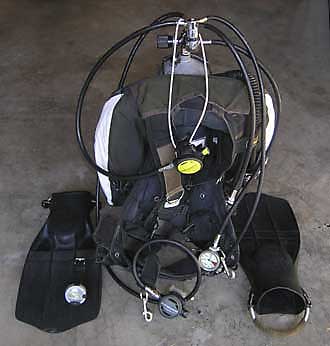

Recreational Gear
Recreational diving respects certain limits, like time and depth, in order to restrict the diver's exposure to risk. Consequently, the safe choices for gear and its configuration are fairly broad. As an instructor and occasional guide, I have seen some oddball gear configurations ranging from comical to suicidal. There are four easy principles to follow when selecting gear:
Gear choices only really become critical in an emergency. This is when someone may pay a price for your gear choices - you, your buddy, or another diver.
When technical diving, I dive what is called the long hose configuration. It is a style of diving developed for cave diving and has been nearly universally adopted by the wreck diving and deep open ocean diving community. In order to dive consistently, I began diving with a long hose configuration in recreational diving. I used to dive with a octo/inflator system until several tense moments with students showed me the difficulty of managing that system with a panicked diver on the other end. The long hose is natural for me and well practiced. It is not necessarily the best for everyone. It is also not a sign that you are a technical diver just because you dive the long hose either.
Here is my cold water recreational kit:

It consists of:
See Gear Links page for links to these brands.
The backup regulator is attached to a lanyard around my neck. It is ALWAYS immediately accessible, even in the most extreme emergency. The primary regulator is on the end of a 6 foot hose. This hose is routed down the right side, under the right arm, across the chest, over the left shoulder, behind the neck, and finally, back over the right shoulder and into the mouth. Jeez, didn't I just say something about simplicity before ??
Long Hose Configuration
The long hose configuration originated with cave divers. If you work your way into some fairly tight holes, you might have to share air in the event of an emergency. To exit the cave, you will have to go back through those tight spots. It may require the divers to go single file through the restriction - hence the origin of the long hose. The draping of the hose across the chest is just simply the best way to stow it under normal use. It is held close to the body and doesn't create an entanglement hazard.
The long hose works the same way as a standard hose during a normal dive. It is in an emergency where the difference appears.
To use the long hose in an emergency, the diver drops their head, taking the reg out of their mouth and pushes it forward to the out of air diver. At the same time, they reach down and bring the secondary regulator on the lanyard around their neck into the mouth. Viola! (This maneuver is the reason that tech divers don't wear snorkels).
To convince folks that this is a worthwhile configuration usually takes a demo or two, so I can't effectively do it here. But just remember back to your Open Water course where you should have done a lap around the pool while sharing air. You had to turn at a strange angle and fight bumping into each other. It was somewhat of a circus. It really gets interesting if it is done in a surgy or high current environment.
Now imagine the long hose. You signal out of air. I hand the long hose off to you and can now swim beside and just behind you. A usual comment that I get about this scenario is that "I don't remember the short hose being that hard to handle?" Just remember that a real out of air is not the gentile exercise you had in OW class. People who hit that last breath -- or believe they have hit that last breath -- are usually in an unreasoned panic. Now imagine the rodeo of getting to the surface under those conditions chained together by a short leash.
The long hose is not for everyone and I am not advocating that you switch. If you do decide to try the configuration, seek out an instructor who can teach it to you properly.